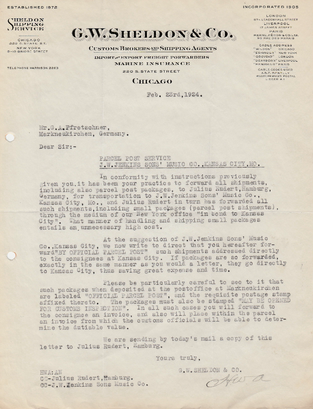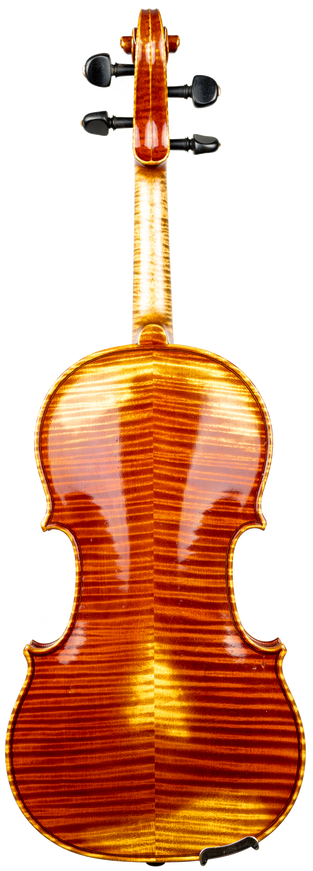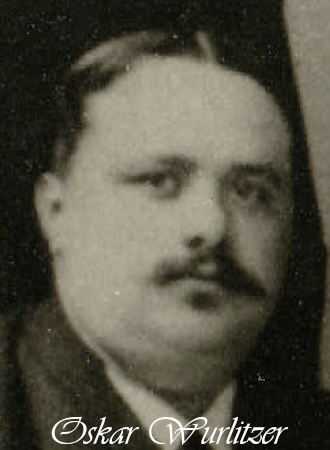Dealers, merchants, manufacturers (part 3)
- G.A. Pfretzschner

- 5. Feb. 2023
- 7 Min. Lesezeit
Aktualisiert: 1. Aug.
Johann Carl Pfretzschner (* 1739) first learned the craft of violin making, just like his brother, and on 28.05.1760, together with six other violin makers, he became a master of the Markneukirchen violin makers' guild. He probably worked in the style of his cousin Carl Friedrich I and used the same templates. On his labels he wrote "Johann Carl Pfretzschner, probe Violin für Lauten, corespondenci Roma Cremona 17..". What pseudo-Latin gibberish. There are still some of the instruments he built in this world, but certainly not many left. This is not surprising, because very soon he began to trade in musical instruments. Together with his cousins and other Markneukirchen master violin makers, he then founded a guild of stringmakers. When this guild was confirmed by Elector Friedrich August III of Saxony on 11.4.1777 for the whole of Saxony with its base in Markneukirchen, he was considered a dealer in musical instruments. He immediately became master of the new guild and was later its chief master. However, the following move of him was really clever. On 4.7.1780 he applied to the Klingenthal violin makers' guild for the master's rights, which he was granted. “...hat sich Meister Johann Carl Pfretzschner von Neukirchen gemelt um bey der alhier befindlichen Erbarn Geigenmacher-Innung (in Klingenthal) das Meisterrecht zu erhalten gebeten. …" In the middle of the "violin war" between the two violin making towns of Klingenthal and Markneukirchen, which lasted for decades, Johann Carl, as a co-master of the Klingenthal guild, now had the right to deliver Klingenthal instruments to his home and business location in Markneukirchen and thus to trade in Markneukirchen.
In 1770 he married Christine Elisabeth Liebel and had five children with her. Four of them were his daughters Christiane Elisabeth, Christiane Sophie, Christiane Eleonore Sophie and Christiane Caroline. Sophie later married Johann Georg Otto and Caroline married Christian Gottfried Schuster, the two most important masters from the early phase of Vogtland woodwind instrument making. All four daughters remain childless. From 1792 until his death in 1797 Johann Carl Pfretzschner was mayor of Markneukirchen and a respected resident. Carl Gottlob I Pfretzschner was born in 1773 as the only son. Like his father, he became a master string maker and manufacturer and a dealer in musical instruments. He no longer learns the violin making trade. In 1802 Carl Gottlob I marries Johanna Caroline Patzschke and has two sons and two daughters with her. Carl Gustav Adolf (* 1805) the later founder of the company G.A. Pfretzschner and Julius Alexander, who was a bookbinder. About Bertha Amalie is only known that she was godmother of Agnes Rosalie Dürrschmidt. Marie Auguste (*1813) married Johann Wilhelm Giers from Adorf.

Carl Gustav Adolf Pfretzschner had learned to be a string maker and in 1861 he was head master of the string makers' guild in Markneukirchen. In 1834 he founded the music business with the company name "G.A. Pfretzschner", which he had registered in the commercial register in 1862. The assortment was wide and contained everything that was needed in the music business. Especially stringed instruments in different quality levels and the corresponding accessories from bows and strings to cases were traded. Furthermore, old and historical string instruments were also traded. There was no own violin maker workshop. Repairs were contracted out to instrument makers in Markneukirchen and the surrounding area. In addition to string instruments, wind instruments, mainly made of wood, were also traded.
Together with Rosalie Wilhelmine Meinhold, whom he married in 1835, Carl Gustav Adolf had nine children, Gustav Adolf, Otto Gottlob, Clementine, Natalie, Leopold Ludwig, Antonie, Liddy, Ottilie and Julie. Rosalie Wilhelmine died at the age of 58 years in Markneukirchen in 1868. Very little is known about the further continuation of the family lines of Otto, Clementine, Antonie, Liddy, Ottilie and Julie and their descendants. The brothers Gustav Adolf (* 1837) and the twelve years younger Leopold Ludwig (* 1849) continue the family tradition as traders. Natalie (*1853) marries Heinrich Theodor Stark, the founder and owner of the company Theodor Stark (Theosta), which was also a manufacturer and exporter of musical instruments. After the death of Theodor Stark in 1898, Natalie became a co-owner of the company from 1899 - 1905 together with the eldest son Willy Stark.
Translated with www.DeepL.com/Translator (free version) From 1865 on, the eldest son Gustav Adolf was co-owner of the company G.A. Pfretzschner alongside his father, and from 1889 to 1905 he was the owner of the company. The younger brother, Otto Gottlob, joined the company in 1869 when his father left, but was only involved until 1891.

During this time the company also became more and more successful internationally. An important step in this process was its participation in the 1876 World Exhibition in Philadelphia, a fact that is still evidenced today by the historical exhibition cabinet displayed in the "Gerber Hans Haus" in Markneukirchen.
The company G.A. Pfretzschner achieved its turnover mainly with string instruments, bows and their components, 90% of which were exported. Around 1900 the company had agencies in half a dozen European and North American cities, including Hamburg, London, Paris, Gothenburg and New York.
In 1880, the first Globus trademark was registered, which from then on appeared on many company printed matter.
Gustav Adolf married Ottilie Sonntag in 1864 and had seven children with her. Adolf Horst, Curt Richard, Martha, Elise, Margarethe Ottilie, Adolf Hans and Käthchen Ottilie. Adolf Horst, Elise and Margarete Ottilie dieed in infancy. Martha later married into the Schuster family and had a daughter, Gertraud. In second marriage she was married to Theo Schwede. Käthe married the manor owner Wolf von Römer in September 1904.
Gustav Adolf und Ottilie


From 1895 to 1899, Gustaf Adolf was also the owner of the signal instrument factory M.C.R Andorff, which he appointed to be continued by his youngest son Hans Adolf. Hans Adolf was then co-owner of the Deutsche Signalinstrumenten-Fabrik M.C.R. Andorff from 1899 and, after Andorff's retirement, operated it together with the then managing director Max B. Martin under the name Deutsche Signal-Instrumenten-Fabrik Pfretzschner & Martin. Hans Adolf was co-owner of the company until 1906, after which Max B. Martin continued to run it on his own.

In 1932, the Deutsche Signal-Instrumentenfabrik, together with fire brigade and police departments, developed a horn that was legally required as a special signal for privileged road users. The protected word mark "Martin-Horn" has existed since this time. Until the 2nd World War, these signal horns for emergency vehicles were produced exclusively by the Deutsche Signal-Instrumentenfabrik. The company was later continued by Max B. Martin alone and today has its headquarters in Philippsburg in Baden-Württemberg.

In 1893, Curt Richard (* 25.10.1865) becomes a partner of the company G.A. Pfretzschner and takes over the company completely in 1905. With up to 10 commercial and technical employees and as employer for numerous craftsmen in and around Markneukirchen, the company was one of the leading Vogtland trading businesses. Under the management of Curt Richard Pfretzschner, the business is further expanded internationally. The business correspondence from all over the world that has been preserved to this day bears witness to this. Among them are letters from London, Örebro, New York, Budapest, Hilversum, Königsberg (today Kaliningrad), Winnipeg, Sandviken, Sundsvall, Yokuhama, Ystad, and many more.
The head office of the trading company was located in the Oberen Straße (old no. 40141 or 35136), i.e. in today's Straße des Friedens 13, until Curt also moved the head office of the company to the residential and commercial building at Oberer Markt 15 in Markneukirchen, which he had bought from his niece, Gertraud Schuster, the daughter of his sister Martha.



Together with his wife Käthe (* 1879, née Merz), whom he married in Markneukirchen in 1898, Curt Richard has a daughter, Margarete (Aunt Gretel) and two sons. The younger one, Wolfgang, spent a year in New York in 1929 with Henry Stadlmair Co.Inc. and travelled the whole country.

After his return in 1930, the two sons Curt Adolf Gerhard (*11.09.1899) and Wolfgang (*14.07.1905) became partners in the company and officially took over in 1935, after the death of their father. Their mother Käthe was limited partner until 1949.
The approx. 100 year old trade office of the company G.A. Pfretzschner, which today is exhibited in the Gerber-Hans Haus in Markneukirchen.
After the Second World War, the economic system of the GDR led to the suppression of private trading companies and to the decline of the once highly differentiated component production. Both affected the G.A. Pfretzschner company, which was nevertheless able to maintain its business activities until 1976. After that, Wolfgang Pfretzschner continued to look after some of his export customers as an employee of the Migma Cooperative and supplied them mainly with played string instruments.

Margarete and Wolfgang remained single and had no children. Curt Adolf Gerhard married Margarete Marie Adele Moßig from Kirchberg near Zwickau in 1934, they had one son, who died early.
This was the end of this important branch of the Pfretzschner family, which made the name famous in many parts of the world, especially at the end of the 19th century.
The familiy property at Oberer Markt was lovingly renovated and is thus preserved as a representative monument for the history of the Markneukirchen musical instrument trade.
As described above, Carl Gustav Adolf had nine children. Not much has been handed down about the six girls and the traces of Otto Gottlob are also lost very soon. He was married to Agnes Thekla Glier (also an old-established Markneukirchen violin making family) and had a daughter Martha Marie Helene with her. She later marries into the Schuster family. The third son of Carl Gustav Adolf was Leopold Ludwig, who was born on 29.09.1849. He became a merchant and initially operated a petroleum trade and was a lottery collector in Markneukirchen. Later he also started trading in musical instruments, but not as successful as his big brother Gustav Adolf. Leopold Ludwig marries Agnes Selma Schuster and has five sons and two daughters. Leopold Horst, Bruno, Rudolf Bernhard, Willi (later lost in Alaska), Mariechen, Hannchen and Alfred. The first-born Leopold Horst (*1879) also becomes a merchant and continues his father's business. He engaged in the import and export of musical instruments and specialized in the trade with violin, cello and bass bows. He imported finest Siberian horse hair for the purchase of bows. He also traded with overseas woods, mainly for the production of woodwind instruments. Leopold also had bows made to order and stamped them with L. Pfretzschner. Some of these bows are still in use today.

In 1904 he married Elsa Wurlitzer, whose parents ran the Hotel zur Post in Markneukirchen. She is closely related to Franz Rudolph Wurlitzer, who emigrated from Schöneck in the Vogtland region to the USA in 1856 and built up the Wurlitzer Empire in Cincinatti, Ohio.
With the outbreak of World War II, this branch of the Pfretzschner family also ceased trading in musical instruments.





























































































